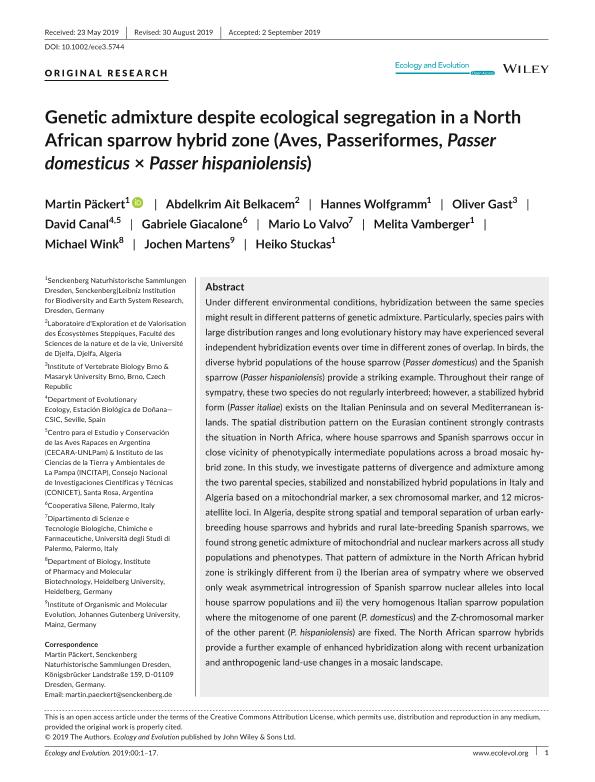Mostrar el registro sencillo del ítem
dc.contributor.author
Päckert, Martin
dc.contributor.author
Ait Belkacem, Abdelkrim
dc.contributor.author
Wolfgramm, Hannes
dc.contributor.author
Gast, Oliver
dc.contributor.author
Canal Piña, David

dc.contributor.author
Giacalone, Gabriele
dc.contributor.author
Lo Valvo, Mario
dc.contributor.author
Vamberger, Melita
dc.contributor.author
Wink, Michael
dc.contributor.author
Martens, Jochen
dc.contributor.author
Stuckas, Heiko
dc.date.available
2020-08-25T20:16:26Z
dc.date.issued
2019-10
dc.identifier.citation
Päckert, Martin; Ait Belkacem, Abdelkrim; Wolfgramm, Hannes; Gast, Oliver; Canal Piña, David; et al.; Genetic admixture despite ecological segregation in a North African sparrow hybrid zone (Aves, Passeriformes, Passer domesticus × Passer hispaniolensis); Wiley; Ecology and Evolution; 9; 22; 10-2019; 12710-12726
dc.identifier.issn
2045-7758
dc.identifier.uri
http://hdl.handle.net/11336/112396
dc.description.abstract
Under different environmental conditions, hybridization between the same species might result in different patterns of genetic admixture. Particularly, species pairs with large distribution ranges and long evolutionary history may have experienced several independent hybridization events over time in different zones of overlap. In birds, the diverse hybrid populations of the house sparrow (Passer domesticus) and the Spanish sparrow (Passer hispaniolensis) provide a striking example. Throughout their range of sympatry, these two species do not regularly interbreed; however, a stabilized hybrid form (Passer italiae) exists on the Italian Peninsula and on several Mediterranean is‐ lands. The spatial distribution pattern on the Eurasian continent strongly contrasts the situation in North Africa, where house sparrows and Spanish sparrows occur in close vicinity of phenotypically intermediate populations across a broad mosaic hy‐ brid zone. In this study, we investigate patterns of divergence and admixture among the two parental species, stabilized and nonstabilized hybrid populations in Italy and Algeria based on a mitochondrial marker, a sex chromosomal marker, and 12 micros‐ atellite loci. In Algeria, despite strong spatial and temporal separation of urban early‐ breeding house sparrows and hybrids and rural late‐breeding Spanish sparrows, we found strong genetic admixture of mitochondrial and nuclear markers across all study populations and phenotypes. That pattern of admixture in the North African hybrid zone is strikingly different from i) the Iberian area of sympatry where we observed only weak asymmetrical introgression of Spanish sparrow nuclear alleles into local house sparrow populations and ii) the very homogenous Italian sparrow population where the mitogenome of one parent (P. domesticus) and the Z‐chromosomal marker of the other parent (P. hispaniolensis) are fixed. The North African sparrow hybrids provide a further example of enhanced hybridization along with recent urbanization and anthropogenic land‐use changes in a mosaic landscape.
dc.format
application/pdf
dc.language.iso
eng
dc.publisher
Wiley

dc.rights
info:eu-repo/semantics/openAccess
dc.rights.uri
https://creativecommons.org/licenses/by-nc-sa/2.5/ar/
dc.subject
HYBRIDIZATION
dc.subject
INTROGRESSION
dc.subject
MICROSATELLITES
dc.subject
MITOCHONDRIAL DNA
dc.subject
Z-CHROMOSOME
dc.subject.classification
Biología

dc.subject.classification
Ciencias Biológicas

dc.subject.classification
CIENCIAS NATURALES Y EXACTAS

dc.title
Genetic admixture despite ecological segregation in a North African sparrow hybrid zone (Aves, Passeriformes, Passer domesticus × Passer hispaniolensis)
dc.type
info:eu-repo/semantics/article
dc.type
info:ar-repo/semantics/artículo
dc.type
info:eu-repo/semantics/publishedVersion
dc.date.updated
2020-04-23T19:18:50Z
dc.journal.volume
9
dc.journal.number
22
dc.journal.pagination
12710-12726
dc.journal.pais
Alemania

dc.description.fil
Fil: Päckert, Martin. Leibniz Institution for Biodiversity and Earth System Research, Dresden; Alemania
dc.description.fil
Fil: Ait Belkacem, Abdelkrim. Université de Djelfa; Argelia
dc.description.fil
Fil: Wolfgramm, Hannes. Leibniz Institution for Biodiversity and Earth System Research, Dresden; Alemania
dc.description.fil
Fil: Gast, Oliver. Institute of Vertebrate Biology Brno y Masaryk University ; República Checa
dc.description.fil
Fil: Canal Piña, David. Consejo Nacional de Investigaciones Científicas y Técnicas. Instituto de Ciencias de la Tierra y Ambientales de La Pampa. Universidad Nacional de La Pampa. Facultad de Ciencias Exactas y Naturales. Instituto de Ciencias de la Tierra y Ambientales de La Pampa; Argentina
dc.description.fil
Fil: Giacalone, Gabriele. Cooperativa Silene; Italia
dc.description.fil
Fil: Lo Valvo, Mario. Universita Degli Studi Di Palermo.; Italia
dc.description.fil
Fil: Vamberger, Melita. Leibniz Institution for Biodiversity and Earth System Research, Dresden; Alemania
dc.description.fil
Fil: Wink, Michael. Ruprecht Karls Universitat Heidelberg.; Alemania
dc.description.fil
Fil: Martens, Jochen. Johannes Gutenberg Universitat Mainz; Alemania
dc.description.fil
Fil: Stuckas, Heiko. Leibniz Institution for Biodiversity and Earth System Research, Dresden; Alemania
dc.journal.title
Ecology and Evolution
dc.relation.alternativeid
info:eu-repo/semantics/altIdentifier/url/https://onlinelibrary.wiley.com/doi/abs/10.1002/ece3.5744
dc.relation.alternativeid
info:eu-repo/semantics/altIdentifier/doi/http://dx.doi.org/10.1002/ece3.5744
Archivos asociados
